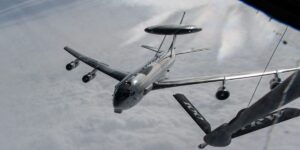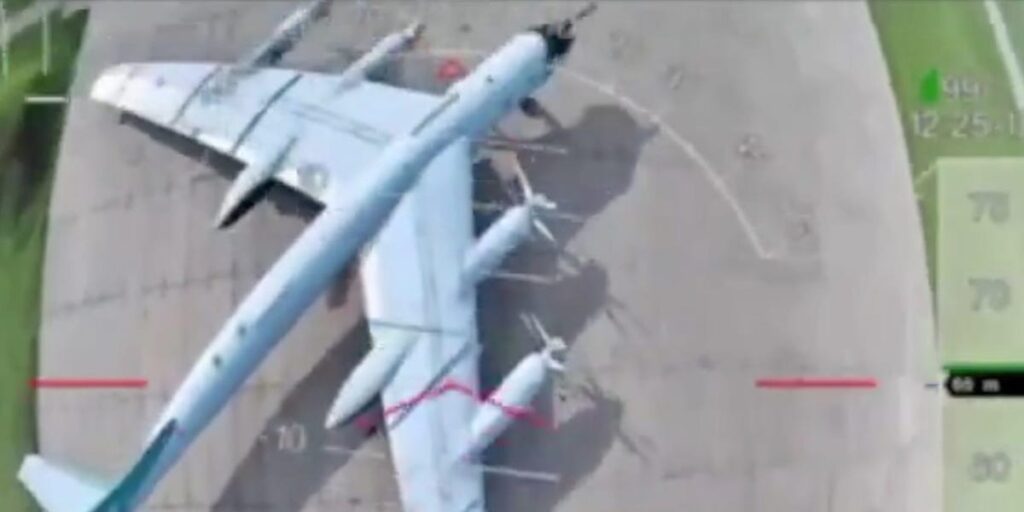The new tactics deployed by Ukraine in striking a claimed 41 Russian warplanes have devastating implications — not only for Russia’s air power but for all advanced militaries, defense experts told Business Insider.
“This attack is a window to future war,” James Patton Rogers, a drone expert and executive director of the Cornell Brooks Tech Policy Institute, told BI.
Ukraine has attacked Russia with drones many times before. But on Sunday, its Security Service, or SBU, targeted four Russian airfields simultaneously with a wildly creative gambit it dubbed “Operation Spiderweb.”
According to the SBU, operatives smuggled the military quadcopters into Russia, later packing them into wooden house-like structures. These were then mounted on trucks, which were driven close to the airfields, where the drones were launched, causing a claimed $7 billion in damage. The proximity and number of small attack drones appear to have given air defense crews little, if any, chance to respond.
While details of the attack need to be independently confirmed, initial visual information suggests that this is “a stunning success for Ukraine’s special services,” said Justin Bronk, an influential air power expert at the Royal United Services Institute.
Here’s what it could mean for Russia and the Ukraine war — and the rest of the world.
Limiting conventional air defences
Ukraine’s previous drone attacks have frequently been countered by Russia’s advanced air defense systems, like its S-300 and S-400 missile launchers. But, it seems, these latest drones didn’t need to run the S-400 gauntlet.
Rather than flying larger, long-range drones through Russian airspace from Ukraine, the SBU said they trucked the containers out to the airfields, activating the smuggled drones after remotely retracting the roofs to release them.
With a much-shortened and simplified journey to their target, the drones struck warplanes at the airfields of Belaya, Diaghilev, Olenya, and Ivanovo, per the SBU.
A powerful statement of Ukraine going it alone
Lithuania’s former foreign minister, Gabrelius Landsbergis, said on Monday that the attack shows Ukraine’s ability to innovate and surprise the world.
“Its scale and ingenuity — carried out without visible Western intelligence or logistical support — suggests Ukraine is now less reliant on outside help,” he wrote.
(Ukraine’s Western backers, like the US, have resisted providing the weaponry and intelligence Ukraine has sought for retaliation against Russian bases, from which it launches regular attacks on Ukrainian civilian infrastructure and defensive lines.)
Powered largely by domestically-produced armaments, Ukraine once again innovated “while the world talks, hosts meetings, and forms yet another ‘coalition of the willing,'” Landsbergis wrote.
“Ukraine is preparing to fight on its own terms,” he added. “If you ever wondered what strategic autonomy looks like — this might be it.”
Ukraine showed that its fleet of $150 million bombers on a runway can be made prey to the kind of cheap drones modified slightly from racing and wedding photos.
It enables Ukraine to hit deeper into Russia
Prior to these coordinated strikes, Ukraine’s drone attacks on Russia have reached as far as 1,100 miles from their shared border.
That distance is dwarfed by the reach of Sunday’s attack, where the farthest airfield, at Belaya in the eastern-central Irkutsk region, was more than 2,500 miles from Ukraine.
Russia likely viewed bases far from Ukraine as being at less risk of attack.
Bronk said that even if only half of the claimed 41 planes were damaged or destroyed, it would have a “significant impact” on Russia’s ability to launch long-range cruise missile attacks on Ukraine’s civilian infrastructure.
Bronk estimates that Russia had around 60 active Tu-95 “Bear” bombers and around 20 Tu-160 “Blackjack” bombers involved in this aerial campaign, and said replacing damaged planes will be a huge challenge, as production on both models has either slowed or halted completely in recent decades.
No hard shelter for planes
Videos and images from the attack show that the planes were parked in the open air, outside of any shelter. This may have made them an easy target.
Satellite images have suggested that this is a point of some anxiety for Russia, which appears to have tried to pile tires onto the wings of its bombers to try to trick visual guidance systems. An aircraft on the ground is highly vulnerable to attack and is wholly dependent on airborne aircraft and nearby air defenses.
Russia is not the only country with this issue.
While China reportedly has enough hardened air shelters to house the majority of its combat aircraft, the US has invested far less in this capability.
‘Sleeper’ drones
Ukraine didn’t detail how it successfully smuggled the drones past Russian authorities. But the fact it did so “highlights the vulnerability of Russian transport and logistics system,” Patton Rogers told BI.
“The question for Russia must be, how many more are lying in wait?” he said.
Meanwhile, Russia has shown itself quick to learn throughout the war, which could worry the West.
The attack is a “stark reminder” of a new phase in war, Karl Rosander, CEO and cofounder of Swedish defence tech startup Nordic Air Defence, said in emailed comments. “One where drones can be covertly deployed and lie dormant behind enemy lines, waiting to strike.”
It’s “only a matter of time” before the tactic is taken up by Russia and other hostile state actors, he added.
The implications of this are wide-ranging. An air base needs a combination of armored shelters for aircraft, electronic jammers to disrupt drone guidance systems, and enough missiles or guns to shoot them down.
All are costs measured in billions of dollars — and Ukraine has just devised a new threat costing in the mere thousands.
Patton Rogers questioned how vulnerable NATO air bases are to such attacks, while pointing out how the tactic could be adopted elsewhere.
“Drones won’t be confined to a set battlefield,” he told BI.
While long-range drones will continue to strike, weaponized short-range drones will be “hidden and waiting for launch” to attack deep inside adversary territory, he said. “The question is, are NATO allies ready for this new reality?”
Read the full article here
















